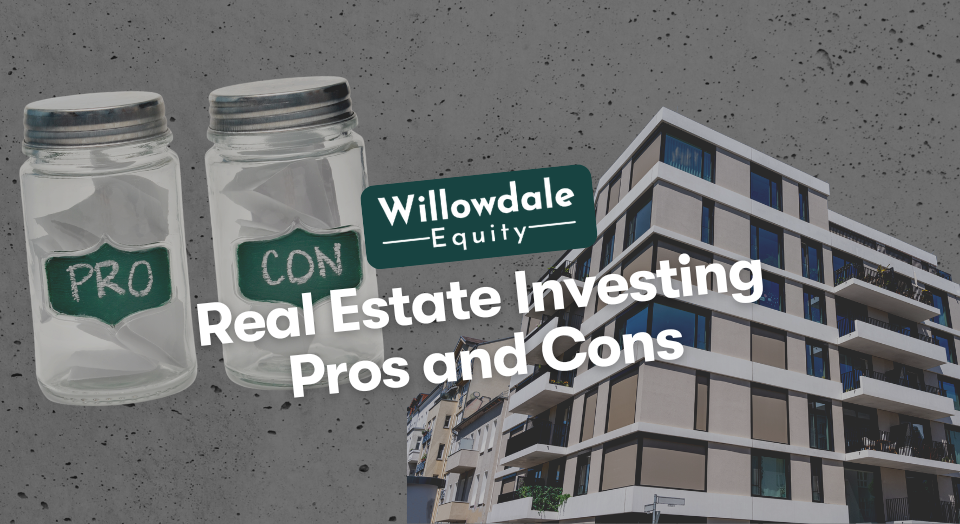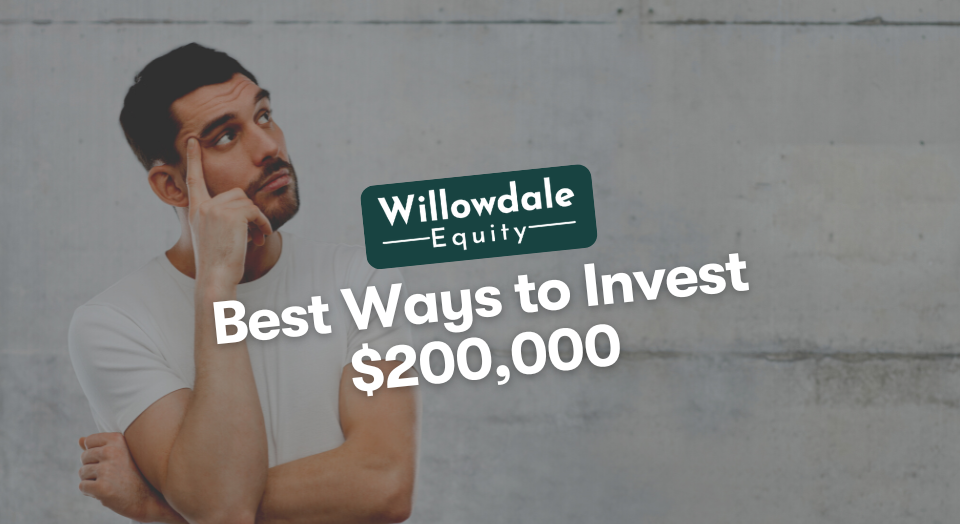
Pros and Cons of Investing in Real Estate in 2024
This article is part of our passive investors guide on real estate syndications, available here.
Real estate is a type of investment strategy used to generate passive monthly income and serve as an addition to a strong investment portfolio. In recent years, it’s been attracting increasing attention from investors who wish to invest their capital intelligently.
However, potential investors can get involved with many types of real estate investments. Learn about each of them, and find out the pros and cons of each one to determine which route is best for you.
Key Takeaways
-
There are many different strategies for investing in real estate, each with its own pros and cons.
-
It’s up to the investor to examine the benefits and downsides of a particular strategy to make an informed investment decision.
Fix and Flip Pros and Cons

A very lucrative idea for many real estate investors can be based on buying properties to fix them up and then selling them at a profit. This strategy is known as ‘fix and flip’ investing.
Pros
- Earning potential: Some homes can be repaired and remodeled very quickly, leaving great profit potential well worth the work and risk associated with the deal.
- Immediate equity: Buying a property that needs repairs creates immediate equity, also called “forced appreciation,” in which the property’s value can increase given the property’s historical value. Likewise, the economical amount and time invested and property quality within real estate appreciates, achieving faster capital growth.
Cons
- Contractors: Contractors are a huge bottleneck for success in the fix and flip game as you are at the mercy of your contractor. If you happen to have a contractor whose slow, does low-quality work, or doesn’t pay attention to detail, the project is vulnerable to failure.
- Time: Repairing and rehabilitating a property is a full-time job that can take months. A fix and flip usually takes about 6-12 months depending on the size of the property, its conditions, and the upgrades your looking to make.
- It’s risky: You can buy a property, repair it, and put it up for sale. But nothing guarantees that you will be able to sell it or make a profit.
Another common and profitable type of real estate investing is investing in land. Let’s look at the pros and cons of this type of investment.
Investing in Land Pros and Cons

Investing in land means purchasing open land that currently has no buildings or structures on it. A real estate investor then builds constructions from the ground up or rent the land to generate income.
Pros
- Less investment cost: If your purchasing power isn’t high enough to invest in high-capacity real estate, investing in land is an excellent option since it offers easy and cheap entry into the market. Land tends to be much more affordable than purchasing entirely constructed properties.
- Easier to buy: When you buy land, you avoid cumbersome procedures such as dealing with tenants, contracting and supervising works or restorations, and the transfer of titles is easier and faster than when buying a house or a lot.
- Doesn’t require maintenance: The maintenance costs of land are much lower than the maintenance costs of a house or a built property. With land, you don’t have to worry about regularly repairing or renovating something. Just take care of surveillance and fence the area that belongs to you.
Cons
- Negative cash flow: While land can be rented for agricultural or advertising purposes, for the most part, land doesn’t generate substantial income. Even so, the owner continues to pay the property taxes on the property and any costs associated with borrowing capital to acquire the said land.
- Financing: Many financial entities decide not to offer loans for land acquisition or require lengthy and complex processes to be approved for credit.
To get around the complications of land investments, some individuals use buy and hold real estate strategies. Let’s take a look at the pros and cons of this strategy.
Buy and Hold Real Estate Pros and Cons
A buy and hold strategy means purchasing real estate, maintaining it, and possibly renting it out in the short term. However, the long-term strategy is to hold onto the investment and sell it when the market is at a high.
Pros
- Continuous income: Buy and hold guarantees a steady cash flow of rental income. As a result, this investment strategy is rarely negative as long as you learn to calculate a rental cash flow.
- Long-term property valuation: buying a rental property and keeping it will always guarantee a long-term appreciation, given the inevitable annual increase in real estate sales
- Inflation adjustments: rents rise with inflation, making their yields will be adjusted to this type of global economic, social, and political situation.
Cons
- Tenant payment evasion: Tenants may refuse to pay the rent exceeding the legal times for said payment. This can lead to evictions and lengthy legal processes or the tenant leaving the rental property in poor condition.
- Property management: Hiring a property management company for all the day-to-day operations is associated with added costs and requires trust in a third-party group to manage the property effectively.
- Property damage: Tenants can misuse or damage furniture, walls, floors, and paint, leading to costly repairs for the landlord.
Another type of real estate investment strategy to be aware of is multifamily property. Let’s take a look at some pros and cons of this type of real estate.
Multifamily Real Estate Pros and Cons

A multifamily property is a property where more than one family lives. Generally, these property investments refer to housing complexes or properties with five or more units per structure.
Pros
- Cash flow: One of the biggest benefits is the opportunity to enjoy a monthly cash flow from the property’s rental income. Unlike buy-and-hold properties, multifamily properties don’t get income from just one rental but several.
- Tax benefits: The tax benefits offered from owning a multifamily property outside of the normal operating expenses include large depreciation or “paper losses” to use to shelter against it’s income. The IRS say’s that you can depreciate multifamily over 27.5 years while only being able to depreciate commercial properties like retail and office buildings over 39 years.
- Scalability: If you’re looking to expand your investments quickly, multi-family investments can be more effective than a single-family residential real estate investment in terms of scalability
Cons
- Higher initial investment: You need a large debt capacity and to find lenders willing to support the purchase or construction of multifamily rental properties.
- More administrative work: You haven’t just one but more than two rental properties that you need to manage, forcing many rental property owners to work with third-party managers.
Lastly, let’s examine the pros and cons of office or retail real estate.
Related Read: How is a Risk-Adjusted Return Calculated in CRE?
Office/Retail Real Estate Pros and Cons

Better known as an investment in commercial properties, office and/or retail real estate investments are focused on commercial buildings, offices, warehouses, and industrial buildings, among others. The strategy of this type of real estate investment is focused on renting spaces of commercial interest.
Pros
- Earning potential: A commercial investment property has great earning potential as it has a high annual yield depending on the location, area, and current economy. This yield range exceeds that of single-family home properties.
- Professional relationships: Commercial rental relationships are often business-to-business, creating strong professional relationships that can benefit a real estate investor in other areas than just a tenant-landlord situation.
Cons
- Property damage: Commercial premises have a lot of foot traffic, which can cause greater and faster wear and tear and lead to costly repairs and remodels.
- Larger vacancy risk: In many office or retail properties, several units or tenants take up most of the property’s leases or total rentable square footage. When these “anchor” tenants can’t pay or choose not to renew their leases, you’re talking about a significant loss in rental income and potentially requiring a capital call to cover costs until you can find a new tenant of that size.
- Longe leases: Some of these leases can be 5 or 10 plus years, and the leases, in most cases, only factors in a small rental increase year over year throughout the term of the lease. The problem with this is that the landlord can’t truly keep pace with inflation like they can in a multifamily property where you renew leases on an annualized basis and adjust your prices to current inflation.
To wrap up, let’s clear up a few frequently asked questions on the pros and cons of investment properties.
Good Read: The 8 Advantages of Real Estate Investing
Frequently Asked Questions About Pros and Cons of Investment Property
It isn’t better or worse to hold or sell real estate. Both strategies have their pros and cons, which means that each investor will need to look at their economic situation, real estate market, and other factors to choose whether to sell or hold a property.
The downside of investing in real estate is that it can be capital intensive and a lengthy process. Additionally, income can be variable, and purchase and rental or property values have the potential to decrease.
Pros and Cons of Real Estate Investing - Conclusion
There are many different strategies for investing in real estate, each with its own pros and cons. It’s up to the investor to examine the benefits and downsides of a particular strategy to make an informed investment decision.
If you want to learn in-depth about growing your wealth through passive real estate investing, join the investor club. You’ll get the tools you need to generate passive income and get access to exclusive multifamily investment opportunities.
Sources:
Interested In Learning More About PASSIVE Real Estate Investing In Multifamily Properties?
Get Access to the FREE 5 Day PASSIVE Real Estate Investing Crash Course.
In this video crash course, you’ll learn everything you need to know from A to Z
about passive investing in multifamily real estate.
We’ll cover topics like earned income vs passive income, the tax advantages, why multifamily, inflation, how syndications work, and much much more!




